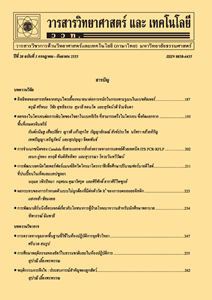การพัฒนาชีวภัณฑ์จาก Bacillus subtilis TU-Orga1 เพื่อควบคุมโรคที่สำคัญของผักคะน้า
Main Article Content
Abstract
บทคัดย่อ
ชีวภัณฑ์ชนิดใหม่จากเชื้อปฏิปักษ์ Bacillus subtilis TU-Orga1 ได้พัฒนาขึ้นด้วยการนำสารพา kaolin : potassium humate : glucose : FeSO4 สัดส่วน 72:8:1:19 เปอร์เซนต์โดยน้ำหนัก มาผสมกับเชื้อปฏิปักษ์ TU-Orga1 (1013 cfu/ml) ปริมาตร 20 มิลลิลิตร/สารพา 1 กิโลกรัม โดยเมื่อเก็บรักษาชีวภัณฑ์ในสภาพอุณหภูมิห้อง (28-33 °C) นาน 12 และ 24 เดือน พบว่าเชื้อปฏิปักษ์ TU-Orga1 มีปริมาณคงเหลือประมาณ 1012 และ 1010 cfu/ml ตามลำดับ ซึ่งชีวภัณฑ์ดังกล่าวยังคงมีประสิทธิภาพในการส่งเสริมการเจริญเติบโตของผักคะน้า โดยกระตุ้นให้สะสม indole-3-acetic acid สูงสุดเท่ากับ 15.21 ไมโครกรัม/มิลลิกรัม น้ำหนักสด และชักนำภูมิต้านทานโรค โดยกระตุ้นให้สังเคราะห์ salicylic acid และ superoxide dismutase สูงสุดเท่ากับ 0.79-0.91 มิลลิกรัม/กรัม น้ำหนักสด และ 13.43-16.78 ไมโครกรัมแคททีคอล/มิลลิกรัมโปรตีน ตามลำดับ ซึ่งแตกต่างทางสถิติกับกรรมวิธีควบคุม เพื่อต้านทานโรคขอบใบทอง โรคเน่าเละ และโรคใบจุดอัลเทอร์นาเรียที่เกิดจาก Xanthomonas campestris pv. campestris, Erwinia carotovora subsp. carotovora, และ Alternaria sp. ตามลำดับ เมื่อทดสอบชีวภัณฑ์ชนิดใหม่ในสภาพแปลงปลูกของเกษตกร จังหวัดนนทบุรี ด้วยการคลุกเมล็ดก่อนปลูกและพ่นใบ จำนวน 6 ครั้ง (เมื่อผักคะน้ามีอายุ 7, 14, 21, 28, 35 และ 42 วัน) เพื่อควบคุมโรคของผักคะน้าที่จะเกิดขึ้นเองในสภาพธรรมชาติ ผลการทดสอบพบว่าชีวภัณฑ์ชนิดใหม่มีประสิทธิภาพในการลดการเข้าทำลายของเชื้อสาเหตุโรคขอบใบทอง โรคเน่าเละ และโรคเน่าเปียก รวมทั้งเพิ่มปริมาณผลผลิตผักคะน้าได้แตกต่างทางสถิติกับการคลุกเมล็ดก่อนปลูกและพ่นใบ จำนวน 6 ครั้ง ด้วยคอปเปอร์ไฮดรอกไซด์ผสมแมนโคเซ็บและกรรมวิธีควบคุม ดังนั้นชีวภัณฑ์ชนิดใหม่ซึ่งมีสมบัติต่อต้านเชื้อสาเหตุโรคพืชที่ได้จากการศึกษาวิจัยครั้งนี้อาจนำไปสู่กรอบการทำงานที่มีคุณค่าสำหรับการเกษตรที่ยั่งยืนในอนาคต
คำสำคัญ : เกษตรอินทรีย์; แบคทีเรียปฏิปักษ์; โรคขอบใบทอง; โรคเน่าเละ; โรคใบจุด; ผลิตภัณฑ์จุลินทรีย์
Abstract
A new bio-formulation of the biological control agent, Bacillus subtilis TU-Orga1 was developed with supporter ratio of kaolin : potassium humate : glucose : FeSO4 = 72:8:1:19 w/w then mixed with 20 ml (1013 cfu/ml TU-Orga1)/kg supporter. TU-Orga1 viability in the formulation stored at room temperature (28-33 °C) slowly declined to approximately 1012 and 1010 cfu/ml after 12 and 24 months shelf life, respectively. The bio-formulation enhanced plant growth by significantly increased indole-3-acetic acid accumulation with 15.21 µg/mg fresh weight and induced resistance by significantly increased salicylic acid and superoxide dismutase accumulations with 0.79-0.91 mg/g fresh weight and 13.43-16.78 µg catechol mg-1 protein against black rot, soft rot, and Alternaria leaf spot diseases caused by Xanthomonas campestris pv. campestris, Erwinia carotovora subsp. carotovora, and Alternaria sp., respectively. Field experiment with seed treatment and 6-foliar spray intervals (7, 14, 21, 28, 35 and 42-day-old plants) of the new bio-formulation was conducted against naturally diseases occurred at Nonthaburi. The new bio-formulation significantly reduced black rot, soft rot, and Choaneohora wet rot pathogens colonization on Chinese kale and exhibited the greatest yield compared to seed treatment and 6-bactericide mixed fungicide spray intervals and nontreated control. The bio-formulation developed and antimicrobial activities may contribute to a valuable framework for a future sustainable agricultural production.
Keywords: organic farming; antagonistic bacteria; black rot; soft rot; leaf spot; microbial product


